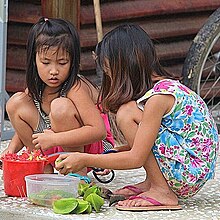Our website is made possible by displaying online advertisements to our visitors.
Please consider supporting us by disabling your ad blocker.
Squatting position

Squatting is a versatile posture where the weight of the body is on the feet but the knees and hips are bent. In contrast, sitting involves supporting the weight of the body on the ischial tuberosities of the pelvis, with the lower buttocks in contact with the ground or a horizontal object. The angle between the legs when squatting can vary from zero to widely splayed out, flexibility permitting. Another variable may be the degree of forward tilt of the upper body from the hips. Squatting may be either full or partial.

Crouching is usually considered to be synonymous with squatting. It is common to squat with one leg and kneel with the other leg.[1] One or both heels may be up when squatting. Young children often instinctively squat. Among Chinese,[2] Southeast Asian and Eastern European adults, squatting often takes the place of sitting or standing.
- ^ Hewes, GW (April 1955). "World distribution of certain postural habits". American Anthropologist. 57 (2): 231–44. doi:10.1525/aa.1955.57.2.02a00040. JSTOR 666393.
- ^ Dobrzynski, Judith H. (17 October 2004). "An Eye on China's Not So Rich and Famous". The New York Times. Archived from the original on 26 April 2023. Retrieved 7 April 2010.
Previous Page Next Page


